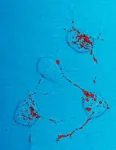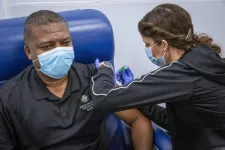Prion diseases: new clues in the structure of prion proteins
Carbohydrates of the prion glycoproteins responsible for a group of neurodegenerative diseases were sequenced for the first time thanks to a highly sensitive technique.
2021-02-19
(Press-News.org) Prion diseases are a group of rapidly progressive, fatal and infectious neurodegenerative disorders affecting both humans and animals: Bovine Spongiform Encephalopathy (BSE) or 'mad cow' disease is one of the most famous since in 1996 scientists found that the agent responsible for the disease in cows, is the same agent responsible for the so-called variant Creutzfeldt-Jakob Disease (vCJD), a disease affecting humans.
A new study carried out by SISSA - Scuola Internazionale Superiore di Studi Avanzati in collaboration with other institutions including Genos Glycoscience Research Laboratory from Zagreb, Croatia and Elettra Sincrotrone Trieste, provides important information on the differences in structures of the prions, proteins responsible for diseases that at the state of the art are incurable.
One of the main unanswered problems revolving around prion diseases is the existence of strains, leading to a wide range of disorders with different symptoms, incubation time, histopathology, etc. "For a better understanding of the mechanism of the diseases and the existence of strains, resolving the structure of the prion protein is necessary" neuroscientist Natali Naki?, first author of the paper "Site-specific analysis of N-glycans from different sheep prion strains", just published in PLOS Pathogens, says. The prion protein is a glycoprotein, meaning polysaccharides called glycans encompass a large part of the protein structure. The new study is the first one of its kind as it focuses on comparing glycan structures from different strains.
Professor Giuseppe Legname, co-author of the paper, is the Director of SISSA Prion Biology Laboratory and has been collaborating with Elettra Sincrotrone Trieste since 2006: "Carbohydrate of the glycoproteins were sequenced for the first time thanks to the collaboration with Genos Glycoscience Research Laboratory, using a highly sensitive technique called Liquid
Chromatography/Mass Spectrometry" he says. "It has long been questioned whether the diversity in prion strains may depend on the glycans that compose them as well as on protein folding. Our results led us to an answer for the first time".
"In this study, glycans from two different sheep prion strains were compared"
Natali Naki adds. "After an extensive analysis, no major differences in glycan structures were found between the two strains, suggesting that glycans may not be responsible for the biochemical and neuropathological differences". A remarkable goal as it represents another step toward the fully understanding of prion glycoproteins and the cellular mechanism of prion diseases.
INFORMATION:
[Attachments] See images for this press release:

ELSE PRESS RELEASES FROM THIS DATE:
2021-02-19
DURHAM, N.H.-- A new report from the University of New Hampshire's Crimes against Children Research Center (CCRC), using data collected by the U.S. Department of Health and Human Services, showed a marked increase in the share of child maltreatment cases resulting in fatalities as well as a decline in cases of physical abuse and neglect in 2019.
The report, which highlights 2019 statistics from the National Child Abuse and Neglect Data System (NCANDS), showed that fatalities rose 4%. The statistics gathered from child protection agencies in each state indicated that the uptick in child maltreatment fatalities was broadly distributed, with 25 states reporting an increase of 10% or more. This increase in fatalities continues an already upward trend ...
2021-02-19
The first global-scale assessment of the role ecosystems play in providing sanitation finds that nature provides at least 18% of sanitation services in 48 cities worldwide, according to researchers in the United Kingdom and India. The study, published February 19 in the journal One Earth, estimates that more than 2 million cubic meters of the cities' human waste is processed each year without engineered infrastructure. This includes pit latrine waste that gradually filters through the soil--a natural process that cleans it before it reaches groundwater.
"Nature can, and does, take the role of sanitation infrastructure," said Alison Parker, a Senior Lecturer in International Water and Sanitation at Cranfield University in the United ...
2021-02-19
SEATTLE -- February 19, 2021 -- A team of scientific experts from across the U.S. and Puerto Rico are advocating for increased diversity in vaccine trials after publishing a new report that highlights a decade's worth of disparities. The new study, published in JAMA Network Open, found that among U.S.-based vaccine clinical trials, people who are Black/African American, American Indian/Alaska Native, Hispanic/Latino and age 65 and older were the most underrepresented groups. Conversely, adult women were overrepresented.
The research team examined 230 U.S.-based vaccine trials of all ...
2021-02-19
What The Study Did: Persistent symptoms among adults with COVID-19 up to nine months after illness onset were analyzed in this study.
Authors: Helen Y. Chu, M.D., M.P.H., of the University of Washington in Seattle, is the corresponding author.
To access the embargoed study: Visit our For The Media website at this link https://media.jamanetwork.com/
(doi:10.1001/jamanetworkopen.2021.0830)
Editor's Note: The article includes conflict of interest and funding/support disclosures. Please see the article for additional information, including other authors, author contributions and affiliations, conflict of interest and financial disclosures, and funding and support.
INFORMATION:
Media advisory: The full study is linked to this news release.
Embed ...
2021-02-19
What The Study Did: This survey study compared patterns of mental health concerns, substance use and suicidal ideation during June and September of the COVID-19 pandemic and examined at-risk demographic groups.
Authors: Mark É. Czeisler, A.B., Monash University in Clayton, Victoria, Australia, is the corresponding author.
To access the embargoed study: Visit our For The Media website at this link https://media.jamanetwork.com/
(doi:10.1001/jamanetworkopen.2020.37665)
Editor's Note: The article includes conflicts of interest and funding/support disclosures. Please see the article for additional information, including other authors, author ...
2021-02-19
What The Study Did: Using data from completed interventional vaccine trials from 2011 to 2020, researchers examined whether racial/ethnic minority groups, females and older adults were underrepresented in U.S.-based vaccine clinical trials.
Authors: Steven A. Pergam, M.D., M.P.H., of the Fred Hutchinson Cancer Research Center in Seattle, and Julie K. Silver, M.D., of Harvard Medical School in Boston, are the corresponding authors.
To access the embargoed study: Visit our For The Media website at this link https://media.jamanetwork.com/
(doi:10.1001/jamanetworkopen.2020.37640)
Editor's Note: The article includes conflicts of interest disclosures. Please see the article for additional information, including other authors, author contributions ...
2021-02-19
Women of minority races and ethnicities and with less education and income have had relatively lower access to 3D mammography, a technology that can improve breast cancer detection and decrease false alarms, according to research published today.
"This study was about whether adoption of this technology is equitable. We're showing that it has not been, even though it has been FDA-approved for a decade now," said END ...
2021-02-19
Recreational hunting -- especially hunting of charismatic species for their trophies --raises ethical and moral concerns. Yet recreational hunting is frequently suggested as a way to conserve nature and support local people's livelihoods.
In a new article published in the journal One Earth, scientists from the University of Helsinki in Finland and Flinders University in Australia have reviewed more than 1,000 studies on recreational hunting -- the first such attempt to summarize the scientific literature examining the biodiversity and social effects of recreational hunting globally.
Co-lead author University of Helsinki Associate Professor Enrico ...
2021-02-19
Creating "super soldiers" of specific white blood cells to boost an anti-tumour response has been shown in a series of elegant experiments by Princess Margaret researchers.
Research led by Ph.D. candidate Helen Loo Yau, Post-doctoral fellow Dr. Emma Bell and Senior Scientist Dr. Daniel D. De Carvalho describes a DNA modifying epigenetic therapy that can transform immune killer T-cells into "super soldiers" by boosting their ability to kill cancer cells.
Their findings could potentially enhance immunotherapy, a new paradigm in cancer treatment currently effective for a minority of cancer patients. Some patients respond well to immunotherapy, with their tumours drastically shrinking in size, but others respond only partially or not at all. Clinicians and scientists around ...
2021-02-19
At some point, microvehicles that are small enough to navigate our blood vessels will enable physicians to take biopsies, insert stents and deliver drugs with precision to sites that are difficult to reach, all from inside the body. Scientists around the world are currently researching and developing suitable microvehicles. In most cases, they are powered and controlled by acoustic and magnetic fields or using light. However, until now, propelling microvehicles against a fluid flow had proved to be a major challenge. This would be necessary for the micromachines to be able to navigate in blood vessels against the direction of blood flow. Researchers at ETH Zurich have now developed microvehicles ...
LAST 30 PRESS RELEASES:
[Press-News.org] Prion diseases: new clues in the structure of prion proteins
Carbohydrates of the prion glycoproteins responsible for a group of neurodegenerative diseases were sequenced for the first time thanks to a highly sensitive technique.




